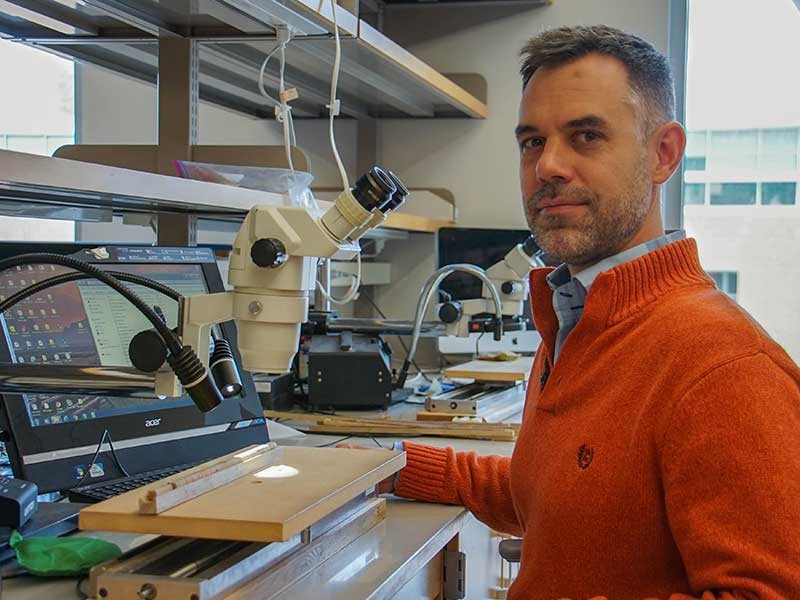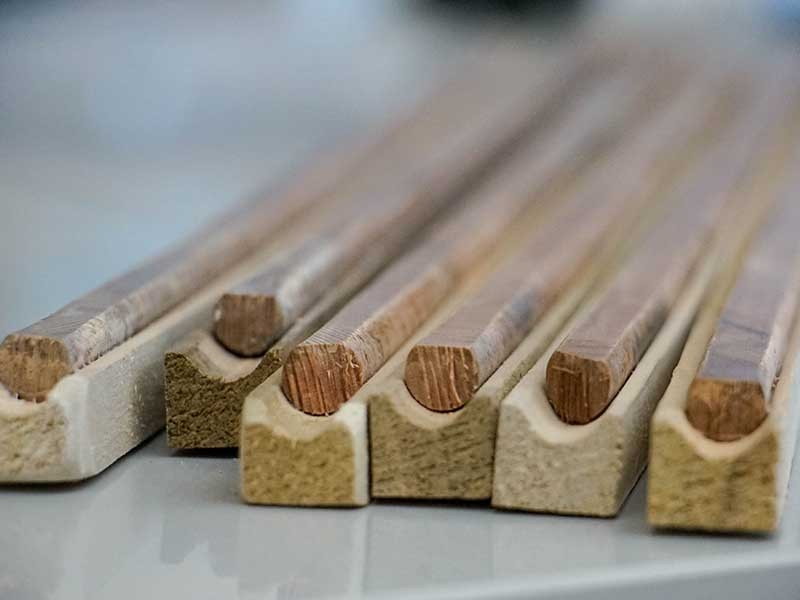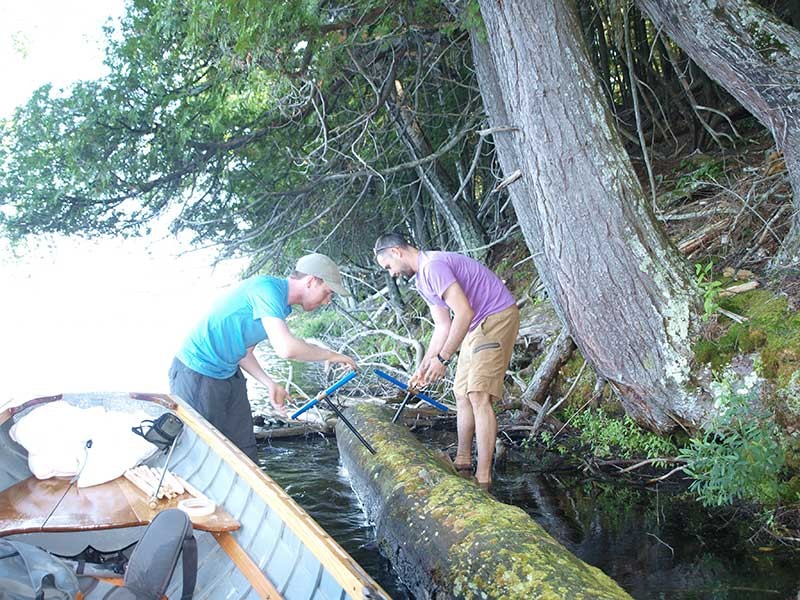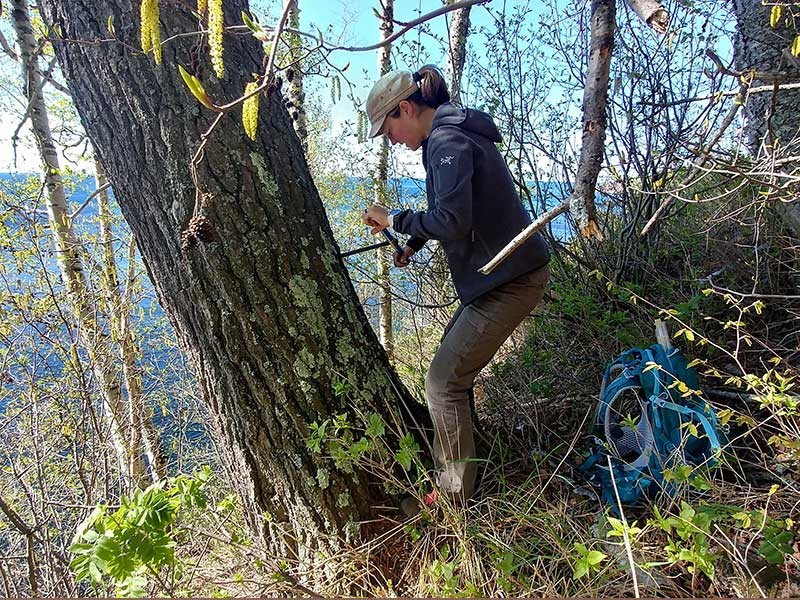Climate History in Tree Rings Builds Understanding of Climate Future
Assistant Professor Steve Voelker analyzes tree rings as part of reconstructing historical climate in order to model future changes.
Knowledge of the past is crucial for adaptation in the future, and research from an ecologist at Utah State University may help promote better understanding of winter weather anomalies by investigating evidence of historic climate and weather.
Steve Voelker, assistant professor in USU’s Department of Plants, Soils and Climate, is the lead author of a paper published in Scientific Reports (a Nature Research publication) in March that provides a proof of concept for the first winter-specific climate reconstruction for the eastern United States.
The article title itself, Tree-ring Isotopes Adjacent to Lake Superior Reveal Cold Winter Anomalies for the Great Lakes Region of North America, requires some knowledge of the complicated interworking of trees and their relationship to climate, but the take home messages are relevant for the entire continent.
Voelker said the paper demonstrates that scientists can reconstruct climate history from analyzing tree rings, “and secondarily the research has connections to both local and
larger-scale climate issues.”
Climate leaves signatures on every living thing, but some trees retain the writing on the wall for hundreds of years. The atomic features of tree rings around the Great Lakes indicate a strong relationship to observed and recorded climate patterns, ice coverage of Lake Superior, and winter temperatures in the region. Observing the connections among these variables in the past allows scientists to make accurate predictions for the future.
Specifically, Voelker is interested in the information contained in trees to learn more about events like the “polar vortex.” This climate phenomenon has gained media traction in the past 10 years because it is associated with record-breaking low temperatures in the Midwest and Northeast regions of the country. The research is funded by the National Science Foundation’s Paleo Perspectives on Climate Change program.
“We hope that we can reconstruct winter polar vortex activity back in time and understand if the huge swings we’ve seen recently are anomalous or if they seem to be related to global temperature,” Voelker said. “In other cases, we have been able to tie winter climate to tree rings very strongly, but it is usually in Mediterranean climates where plants are very dependent on winter precipitation, much like California and Utah. This is really important because it’s the first record that we know of from the eastern United States. It has the potential to be extended back 500 or 1000 years.”
Climate change is projected to increase the variability of climate patterns and events, resulting in more extreme and energetic weather. Voelker said this enhanced variability will cause problems that are difficult to foresee.
“If you’re worried about clearing your roads of snow and you’re under a warmer climate, you’re not going to employ as many drivers on a regular basis or have as many trucks,” Voelker said. “Then again you may need more snow removal because suddenly you have this amplified variability. That variability has a cost in and of itself, and the costs are not as obvious as some people might think.”
The implications are far reaching. Voelker referenced the impact of ice buildup during polar vortex years on the great lakes and its impact on shipping, the cost of heating and energy production during deep-freeze events, travel delays due to extreme storms, and more.
While it’s counterintuitive to imagine a warmer world with more severe winter weather, the unique climate of North America makes this possible. Associate Professor Simon Wang, coauthor of the article and a climatologist at USU, studies how events like the polar vortex are linked to severe drought in the West. Wang’s research has connected the severe California drought of 2013 to 2014 and the recent polar vortex events to an atmospheric circulation pattern known as the “dipole.”
As climate change is expected to amplify the dipole’s effect, the United States faces a unique situation in which climate change will have drastically different impacts on different parts of the nation.
The connected nature of these extreme events in the west and east, make Voelker and Wang’s research important for climate adaptation across the country. Although the trees in this study are nearly a continent away, “they have the potential to improve our knowledge of past drivers of drought and flooding in California,” Voelker said. “That is also important for Utah and other western state.”
The paper is available online at http://tinyurl.com/Nature-tree-rings-climate. Voelker and Wang are co-authors on the paper, along with: Todd Dawson, University of California-Berkley; John Roden, Southern Oregon University; Christopher Still, Oregon State University; Fred Longstaffe, Western University (London, Ontario), and Avner Aylon, Geological Survey of Israel (Jerusalem).
Tree core samples used in the Voelker lab.
Climate scientist Steve Voelker (right) and student research assistant Chris Ratcliff take core samples from a tree submerged in Lake Superior. Voelker's reconstruction of historic climate in the eastern U.S. is a model for predicting unusual climate extremes.
Jessika Pettie collects tree core samples to be analyzed in the Voelker lab in the Department of Plants, Soils and Climate.
WRITER
Jacob Stuivenvolt Allen
Doctoral Candidate
College of Agriculture and Applied Sciences
jacob.stu.allen@usu.edu
CONTACT
Lynnette Harris
Marketing and Communications
College of Agriculture and Applied Sciences
435-764-6936
lynnette.harris@usu.edu
Steve Voelker
Assistant Professor
Department of Plants, Soils and Climate
435-797-2233
steve.voelker@usu.edu
Simon Wang
Professor
Department of Plants, Soils and Climate
435-797-3121
simon.wang@usu.edu
TOPICS
Research 878stories Environment 263stories Plants 186stories Climate 151storiesComments and questions regarding this article may be directed to the contact person listed on this page.












